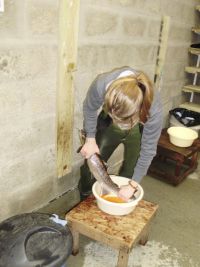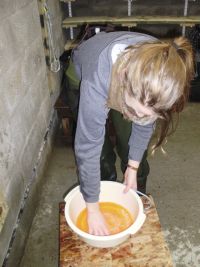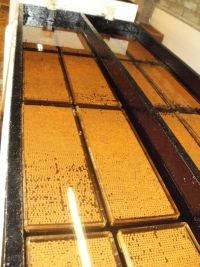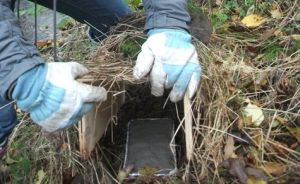Hello Hello!!! It has been really quite a long time since my last blog, many apologies…I blame the snow?! I can do that because I live in the Highlands!
Well yes let’s catch up! The end of 2010 was jam packed with lots of work and meetings and what not including the BBC Live and Deadly event where I got to show off my new stuffed friend there! I had a visit from the lovely Lesley and Suzi and I got to show off the beautiful surroundings in which I work in and show them a couple of the invasive species removal projects I’m working on up here and I even think they enjoyed themselves!
So what have I been up to…well from the Fishery side of things I have been pitching in with the broodstock collection and hatchery operations. Due to hydro power schemes on many Scottish rivers natural spawning habitat for salmon has been destroyed and therefore mitigation measures such as broodstock collection and hatchery operations are necessary in some river catchments.
The wild salmon come into the river system early summer and spend all summer moving upstream to return to their native river. Unfortunately the native spawning grounds above a certain point on one of our river systems has been modified by Hydro power dams so there is a specially built fish trap in a small loch on the system, the fish spend most of their summer here waiting until they are ready to head further upstream to spawn and it is then when they are trapped. The fish are collected every day from the trap and transferred into holding tanks in a building next to the loch. The fish are kept in the tanks and water levels and flows are carefully monitored to ensure fish remain alive. Adult salmon returning to their native rivers do not need to be fed as they do not feed once they entire the river system from the sea, they focus all their energy into their spawning condition. Once the broodstock are collected they remain in the tanks usually separated due to size. Any fish collected straight from the trap which are deemed ‘ripe’ (ready to spawn) are put directly into the spawning baths. They are then placed into anesthestic for a couple of minutes and then taken to be stripped of their eggs and milt. The ratio tends to be 4 hen fish (ladies) to 2 cock fish (males). This is all done with bare hands and believe me its cold work when it’s snowing and minus 8 outside and inside probably! I’ve included these pictures which will hopefully help my explanation!
 Once the eggs and milt are stripped they are mixed and left to stand for about a minute, they then much be washed to remove excess milt and to help the egg ‘hardening’ process. Immediately after the washing the eggs must be left to stand covered in water for an hour, at this stage the eggs are very fragile so this is a crucial stage. After the eggs have hardened they are ready to be transported to the hatchery, they are placed in buckets and driven the 5 min journey down the road to the hatchery building.
Once the eggs and milt are stripped they are mixed and left to stand for about a minute, they then much be washed to remove excess milt and to help the egg ‘hardening’ process. Immediately after the washing the eggs must be left to stand covered in water for an hour, at this stage the eggs are very fragile so this is a crucial stage. After the eggs have hardened they are ready to be transported to the hatchery, they are placed in buckets and driven the 5 min journey down the road to the hatchery building. 
Here there are rectangular troughs which each hold 16 slotted trays, onto these trays a pint of eggs is measured into each one, each pint is made up of approximately 3,000-3,500 eggs depending on whether they are salmon(large eggs) or grilse (smaller eggs). These egg trays have a constant flow of fresh water over them keeping them oxygenated and allowing them to develop. The trays must be checked every day for dead eggs and any dead eggs must be removed as one dead egg can spread a fungal infection through the whole tray killing off all the eggs. Once they eggs have hatched come March time I believe they will be planted into the rivers and burns above the loch in which their parents were caught and develop as normal. There will more on this to follow once it is all underway!
Before the snow came I began a mink monitoring project setting out tracking tunnels along some of the burns that enter into the Cromarty Firth to determine whether mink are travelling along the coasts and then heading inland up these burns and rivers.
 I put out about six…lost a couple to the high tide, replaced them and lost one for good! I picked up some nice prints in one of them that were big enough to be likened to mink prints but I have seen a stoat in the same area and they have similar prints, other prints I’ve picked up have been rather smaller and likely to be mice or voles which is cool too!
I put out about six…lost a couple to the high tide, replaced them and lost one for good! I picked up some nice prints in one of them that were big enough to be likened to mink prints but I have seen a stoat in the same area and they have similar prints, other prints I’ve picked up have been rather smaller and likely to be mice or voles which is cool too!
I have also been compiling information packs on invasive species to distribute amongst local garden centres initially with an emphasis on aquatic plants thanks to funding secured through the BePlantWise campaign..however the big snow came and everyones gardens and ponds seemed to be under a few feet of snow so I’ve delayed that until now when hopefully people will be back in garden centres thinking about their gardens for the year ahead and not to visit Santas grotto! So hopefully get a positive reaction from that. Also going to target local angling clubs and fishing estates as their fishing season starts up soon and the wide network of people involved will be essential in spreading the word about invasive species and preventing potential invasions from some of the worst invasives like American signal crayfish and the Killer Shrimp!
The practical control work that has been ongoing with the fishery trust and BTCV volunteers over the past months has mostly been snowberry and now rhododendron clearance, good mucky hands on work! The Rhodes are being cleared along the river Orrin and we have already seen a huge difference after only a few days work..pix included.
So whats to come in the next wee while…meetings, workshops, rhode bashing, mink, awareness campaing, brushing up on policy and what not…busy busy!
